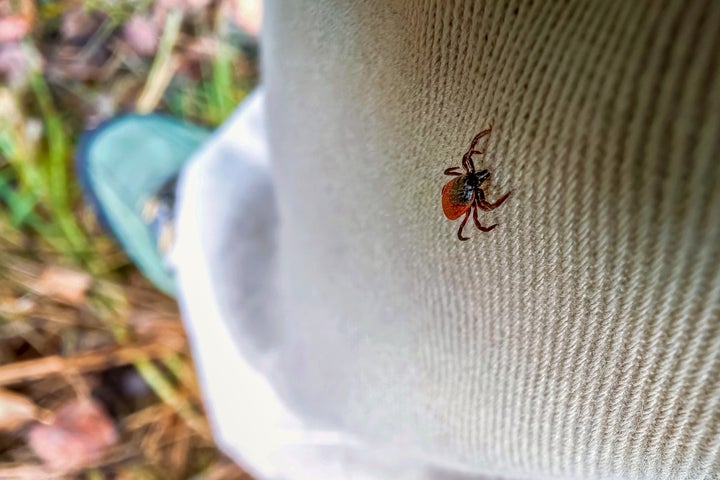🔴 Website 👉 https://u-s-news.com/
Telegram 👉 https://t.me/usnewscom_channel
No one wants to worry about summer illnesses, but there are certain diseases that spread in the warm weather because of tick bites.
“Ticks themselves are not particularly dangerous to humans, it’s just, unfortunately, the diseases that they can carry can be transmitted to humans [and] end up causing them harm,” said Dr. Christopher Bazzoli, an emergency medicine physician at Cleveland Clinic in Ohio.
Lyme disease is the tick-borne illness that gets the most attention. “Right around 90,000 cases of Lyme [disease] are reported to the CDC every year here in the United States, but probably more like [300,000] to 400,000 people contract the Lyme infection annually here in the United States,” Bazzoli noted. That means most infections are not reported to the CDC.
Other, less common diseases that ticks also transmit, Bazzoli said, include Rocky Mountain spotted fever, babesiosis and ehrlichiosis.
Ticks don’t bite you and fly off like a mosquito. Instead, it takes hours and hours for them to cement themselves onto your skin and feed, said Dr. Eugene Shapiro, a professor of pediatrics at Yale School of Medicine in Connecticut. An infected tick (and not all ticks are infected) has to be on for 24 to 36 hours to transmit an infection, Shapiro noted.
“If you identify the tick and can pull it off, usually in less than 36 hours, it’s unlikely it’s going to transmit Lyme disease,” Shapiro said.
“It turns out that most people get infected in their own backyard when they’re gardening or something like that.”
– Dr. Eugene Shapiro, professor of pediatrics at Yale School of Medicine
There are other infections that can be spread more quickly, but it’s generally the tick that you don’t see and don’t pull off that’s most dangerous, Shapiro added.
“Because those can be on for a long time, and most people who do develop Lyme disease don’t identify the tick that transmitted it, because if they’d seen it, more likely than not, they’ll pull it off and it wouldn’t have transmitted infection,” said Shapiro.
The solution to avoiding ticks and tick-borne illness isn’t spending your summer indoors. But ticks and tick-borne illnesses are becoming more prevalent because of climate change, which makes tick prevention strategies even more valuable.
Below, doctors and tick researchers share their guidance for what not to do or overlook when it comes to ticks.
1. Don’t wear dark clothes or fail to cover up when spending lots of time outdoors.
Ticks are generally dark brown or black, which means they can easily blend into dark-colored attire.
To more easily spot ticks on yourself or your loved ones, Dr. Daniel Solomon, an infectious disease physician at Mass General Brigham in Boston, recommends that folks wear light-colored clothing when they’re out and about.
“So, if you see a dark speck crawling around on the clothes, it’s much easier to identify on white or khaki color than dark colors,” said Solomon.
It’s also a good idea to wear long-sleeved shirts and long pants when you’re out in wooded or grassy areas, said Shapiro. While that isn’t ideal for 95-degree weather, it can be the thing that keeps ticks from biting.
You can also consider tucking your pant legs into your socks, which makes it harder for ticks to get in contact with and bite your skin, Shapiro said.
2. Don’t skip insect repellent.
Bug repellent is most associated with keeping away mosquitoes, but certain bug sprays can also keep ticks from biting.
“We have a number of repellents that we can apply [that last] hours at a time,” Bazzoli said. These repellents typically protect folks for four to six hours, unless you’re sweating a lot – in that case, they’ll need to be reapplied more often, he added.
When looking for an insect repellent to keep ticks away, “the big three as far as repellents to choose from — DEET, picaridin-based repellents and then repellents with IR3535 — those are the big three worth recommending,” said Bazzoli.
For both DEET and picaridin, look for formulations that have 20% concentrations, he added.
“And then folks will probably be seeing more products with IR3535, that’s a product that was developed and has been used in Europe for the last decade or two, and is now kind of starting to make its way over to the States and seeing it in some combined products, like sunscreen and insect repellent,” noted Bazzoli.
To deter ticks even more, a bug repellent that can be sprayed onto your clothes will kill ticks on contact, according to Shapiro. It’s called permethrin and can be found online at stores like Amazon, in addition to outdoor gear stores like REI.
“The spray is not toxic to humans, but it can actually kill ticks when they get onto the clothes, and so that’s an extra layer of prevention. If the ticks get onto the clothes, then they can be prevented from getting onto the skin and attaching,” Solomon added.
3. Don’t wander through tall grass.
“Ticks love high grasses, wooded areas, especially the interface between wooded and more open areas,” said Bazzoli. Shapiro added that ticks tend to get on the “ends of blades of grass, and they have sensor organs under their legs, and they clamp onto warm-blooded things that pass by.”
They also live in leaf litter, such as piles of leaves, and shrubbery, added Shapiro. If you have leaf piles in your yard, try to get rid of them, he noted.
“It turns out that most people get infected in their own backyard when they’re gardening or something like that,” Shapiro said.
4. Don’t leave outdoor clothes on after coming inside.
Once again, you shouldn’t be avoiding nature this summer to keep ticks away. You can enjoy your outdoor adventures and stay safe from ticks by following a few rules when you get back inside.
“When you come back indoors, taking off those clothes and throwing them in the dryer on high heat for 10 minutes can kill any ticks that might be freely crawling around,” Solomon said.
Since ticks do not attach right away, you can also jump in the shower to wash off any ticks that may be crawling on your body, he added.
5. Don’t skip tick checks.
When you come in from time outside, you should conduct tick checks with your family members, said Solomon.
“Usually [ticks] like dark, moist areas — behind the knee, in the groin, in the belly button, under the arms or the nape of the neck,” Solomon said.
“Now, they can attach anywhere, but those are the places where they like to attach, and those are also the places that are hard to see, so you really have to, with a family member, make sure that you’re looking in the dark areas that you might not look when you’re going about your regular day,” said Solomon.
If you do find a tick attached to your body, get a pair of fine-tip tweezers, grab as close to your skin as possible, and pull the tick out, Shapiro said.
6. Don’t ignore that pets can carry ticks, too.
It’s also important to be mindful of where your pet goes outside.
“Just because we’re not walking in the woods, if we’re letting the dog out to run through the woods, in the park or whatever, she or he may pick up a tick and carry it inside,” said Bazzoli.
You should chat with your vet about the best tick prevention strategies for your furry friends, he noted. Not only will this protect them from tick bites and infection, but it will protect you, too.
If you do pull off a tick, let your doctor know — there are treatments available.
“If you do remove a tick, we can prescribe an antibiotic for post-exposure prophylaxis, so a single dose of doxycycline can be given,” said Solomon.
You can call your doctor or visit urgent care to get this medication.
“If it’s given within the first 72 hours after tick removal, it can dramatically decrease the risk of Lyme disease,” Solomon noted.
Throughout the summer, you should also be aware of the signs of tick-borne illness. When it comes to Lyme disease, keep an eye out for a red rash, whether it’s a bullseye or any other shape, said Bazzoli.
Beyond a rash, folks with tick-borne illnesses also report flu-like symptoms such as fever, chills or body aches, added Solomon. So, you shouldn’t brush these things off as a “summer flu,” he noted.
“In the spirit of trying not to make people nervous, they’re really treatable, so if you have those symptoms, getting the right testing, getting the right treatment, can help resolve symptoms fairly quickly,” Solomon said.
Not all ticks carry disease, and where you live and when you find a tick can determine if you’re at risk of tick-borne illness. To help you decide what you should do if you find a tick in your home, on yourself or on a loved one, you can use the CDC’s tick bite bot.
“The CDC actually has a tick bot where you can actually answer a series of questions to see what you need to do if you’ve been bitten by a tick or had a tick on you,” Bazzoli noted.
“It’ll kind of guide you, whether you need to see the doctor or if you’re doing OK,” Bazzoli said.

